Tim Warnes's Blog: My Life in Books, page 10
July 23, 2021
We All Play / kimêtawânaw
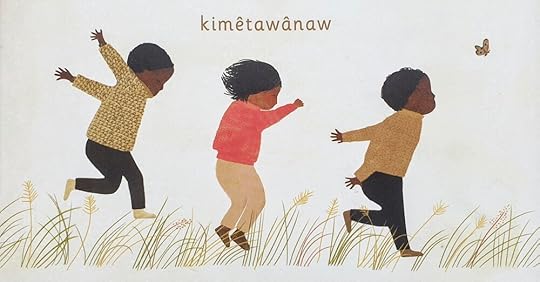
We All Play / kimêtawânaw by Julie Flett (Greystone Kids, 2021) | Illustration © 2021 by Julie Flett
This year I discovered the work of Julie Flett, and I am totally hooked.Her most recent picture book is We All Play / kimêtawânaw (Greystone Kids, 2021). Her characterisation - of both children and animals - is delightful. She describes the book as a celebration of ‘diversity and the interconnectedness of nature through an Indigenous perspective’. Because Flett is a Cree Métis author, illustrator and artist. And her work taps into (or should I say is fed by) those roots - making for some unique picture books.
Flett’s compositions are simple and uncluttered. In We All Play, the animals are big and bold (placed against a textured off-white background), meaning our attention is solely on them. The creatures (native to Canada) are diverse and beautifully illustrated with muted tones in soft watercolour.
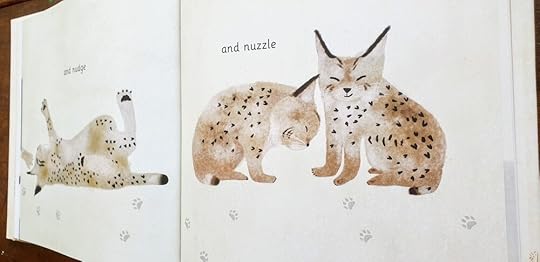
We All Play / kimêtawânaw by Julie Flett (Greystone Kids, 2021) | Illustration © 2021 by Julie Flett
As one review noted, the illustrations have an ‘enticing texture’. They make you want to reach out and sink your fingers into deep fur or scrunch them into someone’s warm jumper. Aside from being visually pleasing, this will only add to the appeal to young kids to whom the book is aimed.
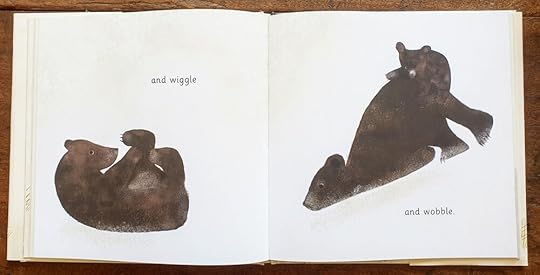
We All Play / kimêtawânaw by Julie Flett (Greystone Kids, 2021) | Illustration © 2021 by Julie Flett
One of my favourite spreads is of the bears in the snow who ‘wiggle and wobble.’ I have seen a shed load of bears in picture books. Flett’s bears are noteworthy for being so darn adorable and (appropriately enough) playful! Aside from their claws (which look razor-sharp), her animals look incredibly soft. And oh! that baby bear’s face!
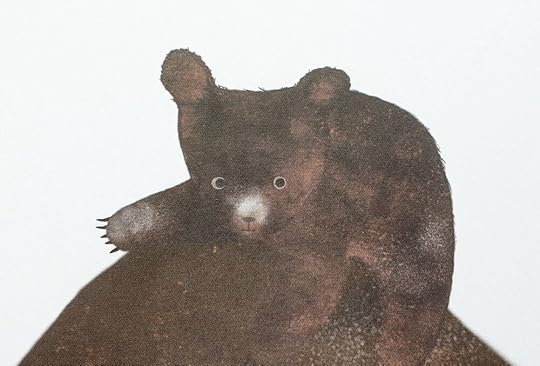
We All Play / kimêtawânaw by Julie Flett (Greystone Kids, 2021) | Illustration © 2021 by Julie Flett
Each spread uses playful alliteration to describes the featured animals. (For example, seals ‘bubble and bend.’ Buffalo ‘rumble and roll.’) Flett’s vocabulary is rich, and the text has a lilting, sing-song quality that makes it a pleasure to read aloud:
Animals hide and hop
And sniff and sneak
And peek and peep.
The text is minimal. Kirkus Reviews notes the ‘[a]nimals are not named within the primary text, leaving it to readers to identify the hopping bunnies, the spouting beluga whale calves, and the yawning wolf pups’. Yet despite its apparent simplicity, We All Play is clever and has several visual elements that might be conversation starters with young kids. For example, if you look closely at the opening spread, you’ll see a little grasshopper hiding and hopping alongside the rabbit. These features make We All Play a perfect book to share with the very young at whom it’s aimed.
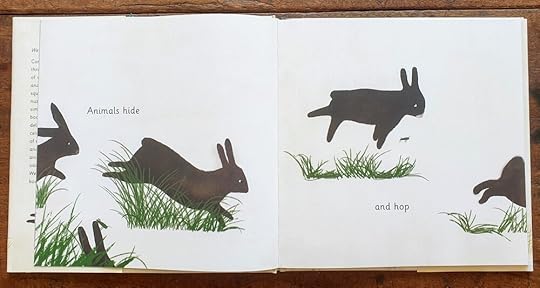
We All Play / kimêtawânaw by Julie Flett (Greystone Kids, 2021) | Illustration © 2021 by Julie Flett
Interspersed amongst the animals playing are groups of children (whose play reflects their animal counterparts). Lying in the grass or splashing in the water, the children repeat the joyful refrain, ‘We play too!’ (followed by the Cree translation: ‘kimêtawânaw mîna’).
In an interview with Art of the Picture Book, Flett shares why she likes to include Cree translation in her work:
When I started working on kids’ books, I was learning about the languages that my grandparents [spoke]… I thought this was something I could share with kids and ... contribute to my community through artwork and storytelling.
Elsewhere, Flett explains: “We didn’t have any books representing us, our parents or grandparents when we were growing up,” she says. “That hit me.”
Now Flett advocates for indigenous youth and other community members, helping to preserve (and share) indigenous languages among English-speaking populations. She also represents indigenous children through ‘the gorgeous skin tones [which] range from deep copper-brown to beige.’ (Horn Book Review). It’s so important that children of all races and colours (and abilities) get to see themselves represented in literature - and that includes picture books.
Flett’s Indigenous perspective is pretty unique. It allows her to quietly highlight her heritage, mainly through the inclusion of Cree and Michif languages. She explains:
“When I started working on kids’ books, I was learning about the languages that my grandparents had spoken, and I thought this was something I could share with kids and ... contribute to my community through artwork and storytelling.”
It’s significant, too, that in a cutaway scene of children swimming underwater, one girl has a malformed arm. I don’t mean it’s poorly drawn - Flett is way too good for that. Instead, it’s a thoughtful, inclusive moment where she has consciously chosen to portray a child with a disability. This is important because it reflects the world that children see around them - and that some individuals, unfortunately, experience first-hand.

We All Play / kimêtawânaw by Julie Flett (Greystone Kids, 2021) | Illustration © 2021 by Julie Flett
‘These are the small but important details that allow children to see themselves in books’ notes CM: Canadian Review of Materials. It’s a two-sided coin of tremendous value. One side affirms the child being represented. On the flip side, such details broaden other children’s horizons. They increase awareness and understanding and will encourage your child to look outwards at the experience of others.
We All Play is a message of unity. Flett presents a timely reminder (told through the subtle parallels of shared play) that we are all connected with nature and with each other - regardless of culture.
As the story draws to a close, the now-tired animals fall asleep ‘slowly, side by side’ and the children reply, ‘We do too.’

We All Play / kimêtawânaw by Julie Flett (Greystone Kids, 2021) | Illustration © 2021 by Julie Flett
We All Play / kimêtawânaw is a gentle and quiet book. It stands out for its beautiful, textural illustration and poetic text. Flett’s Cree-Metis heritage has shaped her work and purpose. But the inclusion of Cree words is not a gimmick. Rather than driving the book, it’s a beautiful addition that enhances the experience. (The end of the book has a list of featured animals in both Cree and English, with guidance on pronunciation.)
Most importantly, We All Play is an invitation – and opportunity – for you to engage with your child – and play! Because connection should be at the heart of every storytime.
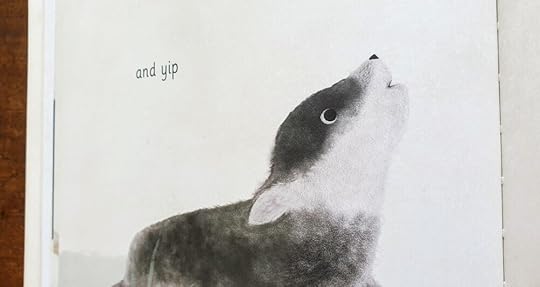
We All Play / kimêtawânaw by Julie Flett (Greystone Kids, 2021) | Illustration © 2021 by Julie Flett
STORIES WORTH SHARING: We All Play / kimêtawânaw by Julie FlettGood to Read because:
It’s a joyful celebration that diversifies your child’s bookshelf. Here’s how:
It introduces your child to a range of uncommon animals, including buffalo and bobcats.
The children depicted feature a range of (darker) skin tones.
The inclusion of some Cree words is a playful addition that broadens your child’s horizons.
The simple, sing-song text will engage young children. Perfect for reading aloud (and developing their literacy skills).
It reminds us that we are interconnected and live in relationship - to each other and to the natural world.
Picture books for younger children
Goodnight Moon by Margaret Brown and Clement Hurd
Maisy at the Farm by Lucy Cousins
Tiny Little Fly by Michael Rosen and Kevin Waldron
Say Hello to the Dinosaurs by Ian Whybrow and Tim Warnes
BUY THE BOOKPowered by Bookshop.org
Supporting independent bookshops
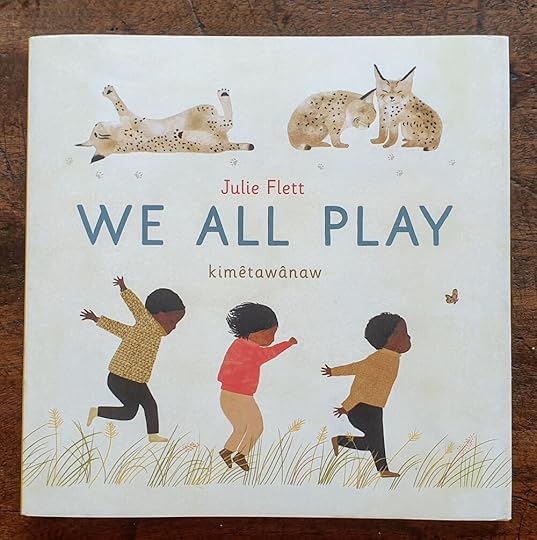
We All Play / kimêtawânaw by Julie Flett (Greystone Kids, 2021) | Illustration © 2021 by Julie Flett
‘spectacular in its seeming simplicity.’
- Seven Impossible Things Before Breakfast‘a great candidate for read-aloud and storytimes.’
- Canadian Review of Materials buy us bUY UK* I EARN COMMISSION FROM THESE LINKS #AD/AFFSOURCESWe All Play / kimêtawânaw by Julie Flett (Greystone Kids, 2021) Julie Flett (Julieflett.com) We all Play (Patricia Cambpell Clarkson, spiritualityandpractice.com)Julie Flett’s We All Play / Kimêtawânaw (Seven Impossible Things before Breakfast, 21 june 2021) An Interview with Julie Flett (The art of the picture book, 14 may 2021) Julie Flett is reclaiming Indigenous themes of community and language through her children's books (rYAN B. pARTICK, 30 JUNE 2020) Review of We all Play (Autumn Allan, The Horn Book Inc, 7 june 2021) We All Play = kimêtawânaw (Cmreviews.ca)Related articles****© 2021 BY TIM WARNES(UNLESS OTHERWISE ATTRIBUTED)USE OF THIRD PARTY COPYRIGHTED MATERIAL FALLS UNDER FAIR USE/FAIR DEALING PRACTICE.July 16, 2021
How a gentle lion named Leonard will develop your child’s empathy

From How To Be A Lion by Ed Vere (Puffin, 2018) | Illustration © 2018 by Ed Vere
I have always been a bit of an outsider.As a kid, I was weedy and asthmatic (and way more interested in the birds on the sports field than the game around me). Quietly creative - a gentle bookworm who was easily intimidated. Most definitely an introvert who liked his own company. It’s only in recent years (thanks mainly to my therapist) that I have embraced my version of masculinity and learnt to celebrate myself! If only I’d grown up with this week’s Story Worth Sharing: How To Be A Lion by Ed Vere (Puffin, 2018).
How To Be A Lion poses the question: Can a lion be anything other than fierce? (Extrapolate that further, and the question is: Must I conform to preordained ideas?)
The star of the story is a gentle lion named Leonard.
Leonard loves to walk by himself, feeling the sun warm his back and the grass under his paws.
Leonard (as noted in Kirkus Reviews) ‘is aware that the general expectation of lions is to be fierce. [But] he opts not to live up to it. Instead, he…thinks up poems, and befriends Marianne, a duck.’

From How To Be A Lion by Ed Vere (Puffin, 2018) | Illustration © 2018 by Ed Vere
The story, notes BookTrust, ‘is warm and reassuring’. In part, that’s due to Vere’s friendly characterisation and use of a predominantly orange/red palette. I also agree with BookTrust that Vere’s writing, too, has a warmth reminiscent of Winnie-the-Pooh. (Like Pooh, Leonard has a thinking hill where he ‘thinks important thoughts’ and daydreams.)
Somewhere in between, he hums quietly and plays with words.
Putting them together
this way, then that way -
making them into poems.
(There’s a charming image of Leonard and Marianne, lying side by side, engrossed in their reading. (Look closely, and you’ll see Leonard’s book is Robert Frost’s The Road Not Taken, while Marianne reads Emily Dickinson.))

From How To Be A Lion by Ed Vere (Puffin, 2018) | Illustration © 2018 by Ed Vere
One day a pack of fierce lions came prowling around.
The archetypal big boys, the bullies: Those who are challenged by behaviour that they consider abnormal.
“What’s going on here?” they growled.
“Why hasn’t this duck been chomped?”
“This duck is Marianne,” said Leonard.
“She’s my friend and nobody will chomp her!”
I am still easily intimidated - so I feel for poor Leonard, who puts a protective paw around Marianne.
In Leonard, Vere presents an alternative male role model: ‘[A] strong-looking lion who thinks for himself, choosing creativity and friendship over superficial toughness.’ [Kirkus Reviews]
He’s a reminder that, sometimes, we must stick up for ourselves - and our friends. Even when pressured by those who are bigger (and fiercer) than ourselves.

From How To Be A Lion by Ed Vere (Puffin, 2018) | Illustration © 2018 by Ed Vere
Studies show that stories (including picture books for the very young) develop emotionally healthy children.How?
By modeling empathy - defined by WorldReader as ‘the ability to understand and experience the feelings of others, and to respond in helpful ways.’ Picture books like How To Be A Lion are essential for teaching this skill.
Vere’s expert storytelling will leave kids in no doubt about how Leonard feels. Just look at the heartbreaking image that follows Leonard’s interaction with the fierce lions. A heavy cloud – of despair, melancholy, and sadness – hangs over him in a wordless image that speaks volumes. To be fierce is not in Leonard’s nature. And he doesn’t want to change. Why should he? He’s happy being himself!
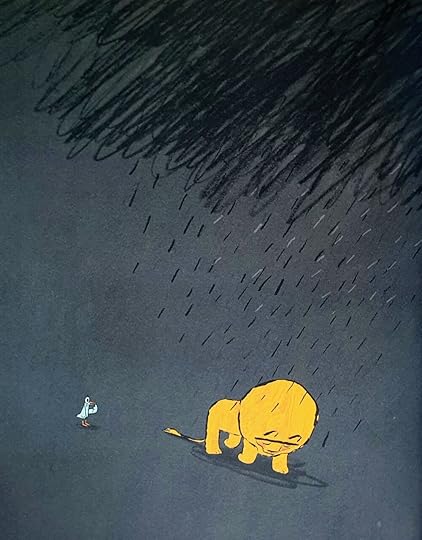
From How To Be A Lion by Ed Vere (Puffin, 2018) | Illustration © 2018 by Ed Vere
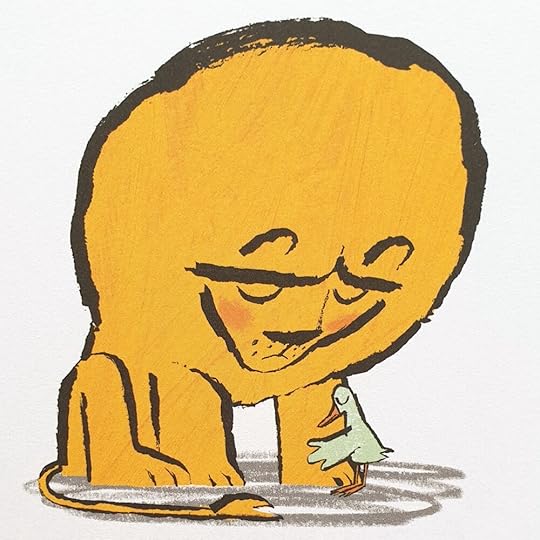
From How To Be A Lion by Ed Vere (Puffin, 2018) | Illustration © 2018 by Ed Vere
Thank goodness his friend, Marianne is at hand to support him.
Children need to develop empathy because it is central to living a successful life. Empathy leads to healthy, compassionate relationships. It helps children understand that we are all unique - and that difference is something to be celebrated.
In a nutshell: Empathy is good for both your child and society.
Leonard and Marianne need a plan. They sit together and think.
Ideas start to form.
They put their words together,
like this, like that, building them into a poem
that made sense of what they thought.
Finally, Leonard and Marianne confront the fierce lions. Bravely refusing to eat his friend, Leonard supports his decision with their poem, affirming their belief that no one way of being is true. In other words, Leonard finds the courage to be himself - a daydreaming, duck-loving poet!
Leonard concludes:
“If there must be a must, then this we must try…
Why don’t you, be you…
And I, will be I.”

From How To Be A Lion by Ed Vere (Puffin, 2018) | Illustration © 2018 by Ed Vere
One of the greatest gifts we can give children is the confidence to stand up for what they believe in and the courage to think for themselves.
To be brave (like Leonard) in the face of bullies. So, it may come as no surprise to learn that Vere wrote How To Be A Lion during the 2016 US election. His response (he says) to Trump’s bullish voice and narrow concept of masculinity. Vere expands on this in an article from The Guardian:
“Too often strength and sensitivity are presented as mutually exclusive… We need to teach compassion, respect and empathy at an early, foundational age. If we can teach this to boys at around five, and demonstrate that being gentle, sensitive or emotionally engaged isn’t a weakness, but part of being a fully rounded grown-up man, then we’re getting the message through to them before toxic attitudes have a chance to solidify.”
- Authors steer boys from toxic masculinity with gentler heroes (The Guardian)
Brilliant! A picture book that challenges traditional ideas of masculinity. ‘One that’, as Vere writes on his website, ‘doesn’t bully and belittle’.
‘Positive role models showing boys how to be a whole person are few and far between these days’, notes Kirkus Reviews. ‘This marvelous book triumphs in that essential job.’
And a triumph it is! Look closely in the background of the final spread, and you’ll see that at least one of the fierce lions has taken Leonard’s message on board - and has his nose in a book!
STORIES WORTH SHARING: How To Be a Lion by Ed VereGood to Read because:
It will develop your child’s empathy.
It challenges what it means to be masculine by presenting an alternative male role model in Leonard.
It celebrates being an individual - thinking for yourself and standing up for who you are.
(Use the book to spark conversation with your child: What makes them unique?)
GOOD TO READ
Picture books celebrating the individual
Only You Can Be You! by Nathan Clarkson, Sally Clarkson and Tim Warnes
Julian is a Mermaid by Jessica Love
Mr Big by Ed Vere
Boris Starts School by Carrie Weston and Tim Warnes
BUY THE BOOKPowered by Bookshop.org
Supporting independent bookshops
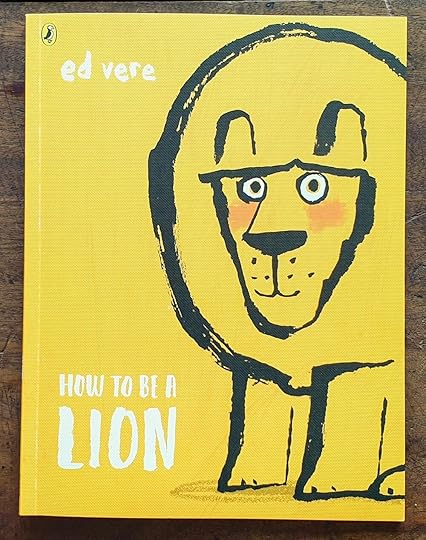
From How To Be A Lion by Ed Vere (Puffin, 2018) | Illustration © 2018 by Ed Vere
‘A philosophical tale so, so full of heart, celebrating the quietest and gentlest among us.’
- Library Mice‘Children will feel empowered’
- School Library Journal Buy UK Buy US* I EARN COMMISSION FROM THESE LINKS #AD/AFFdon’t forget – you can always borrow my recommendations from your public library! SOURCESHow To Be A Lion by Ed Vere (Puffin, 2018) Kirkus Review: How To Be A Lion BookTrust review: How To Be A Lion https://www.booktrust.org.uk/book/h/how-to-be-a-lion/ 7 Books That Inspire Empathy in Children by Selena Garrahan (WorldReader.org)Ed Vere on instagram Authors steer boys from toxic masculinity with gentler heroes by Donna Ferguson (The Guardian, July 14, 2018)Ed Vere’s websiteTime for Storytime: Ed Vere reads How to be a Lion (BookTrust on YouTube)Related articlesMax at Night: A perfect bedtime readFrom boys to men: how picture books can shape the futureTeaching empathy through picture booksPretty in pink© 2021 BY TIM WARNES(UNLESS OTHERWISE ATTRIBUTED)****USE OF THIRD PARTY COPYRIGHTED MATERIAL FALLS UNDER FAIR USE/FAIR DEALING PRACTICE.July 9, 2021
The Great Cheese Robbery: How Daddy Elephant empowers your kids
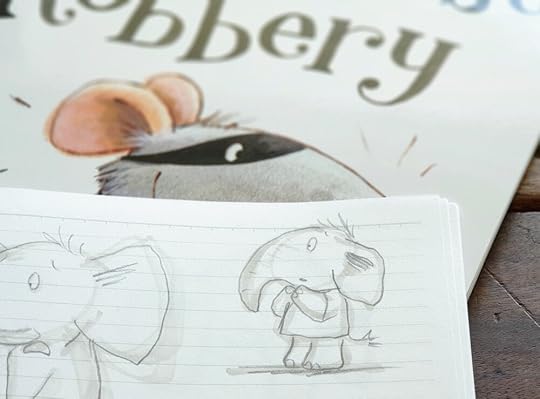
Development work: The Great Cheese Robbery by Tim Warnes (Little Tiger Press, 2015) | Illustration © 2014 by Tim Warnes
I thought I’d share another picture book on the theme of fear, this time one of my own: The Great Cheese Robbery (Little Tiger Press 2015).I checked through my files and found the earliest draft of Cheese Robbery. It’s simply titled: ‘elephant & mouse’. At the top is written my synopsis:
This is the story of a little elephant who is scared of lots of things and a much bigger elephant who isn’t scared of anything - well, almost nothing...
*squeak*
Fear (as so expertly portrayed in last week’s recommendation) plays a part in everyone’s lives - whether you are big (like Daddy Elephant) or small (like Patrick).
And when you’re small, there’s plenty to be scared of!
Patrick [Elephant] was scared of lots of things, like the dark, ghosties, bees, and the fluff you find under the sofa.
But Daddy Elephant (who ‘was as big and as strong as a tractor… wasn’t scared of anything.’
Or so he’d like everyone to believe…

Development work: The Great Cheese Robbery by Tim Warnes (Little Tiger Press, 2015) | Illustration © 2014 by Tim Warnes
Because Daddy Elephant had a secret fear.
One afternoon there was a squeak at the door.,
” Look, Daddy,” gasped Patrick. “A teeny-tiny elephant!”
‘That’s not an elephant,” cried Daddy.
“IT’S A M-M-M-MOUSE!
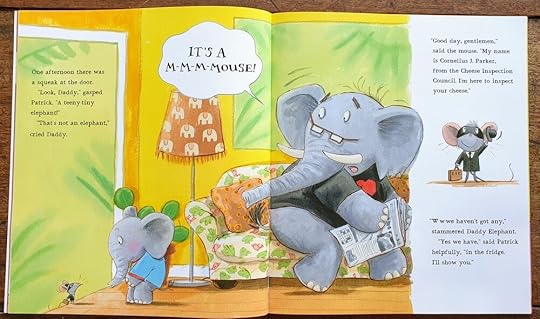
From The Great Cheese Robbery by Tim Warnes (Little Tiger Press, 2015) | Illustration © 2015 by Tim Warnes
With bare-faced cheek, a mouse called Cornelius J. Parker (believe it or not, the name just popped into my head!) turns up at the elephants’ house.
Patrick is wide-eyed and innocent. Rather than being spelt out in the text, this is demonstrated by his words and actions.
For example, Patrick mistakes the visitor for a minuscule elephant.
When the mouse announces that he’s from the Cheese Inspection Council, Daddy stammers, “W-w-we haven’t got any.” Patrick corrects him: “Yes we have,” said Patrick helpfully, “in the fridge. I’ll show you.” When Cornelius realises he’s hit the cheese jackpot, he calls for backup.

From The Great Cheese Robbery by Tim Warnes (Little Tiger Press, 2015) | Illustration © 2015 by Tim Warnes
Seeing the burglar mice struggling with the fridge, Patrick runs to their aid. (“Don’t worry - I’ll help!”)
Dear sweet little Patrick. So young and naive!
And all the while, poor old Daddy Elephant cowers and trembles behind the sofa - paralysed with fear.
(By the way, you know the old saying, that elephants are afraid of mice? It dates back to the Roman philosopher Pliny, the Elder. Way back in A.D. 77, he began ‘the impressively persistent rumor’ that elephants hate mice and rats above all other creatures. The team on Mythbusters tested the claim. Their result was inconclusive - it could be that their test subject was afraid of the mouse. Or felt empathy and was concerned about squashing it underfoot. Either way, the elephant certainly avoided the mouse.)
Here’s how I came up with the idea of burglar mice: By doodling! I’d been noodling with the concept (around elephants being scared of mice) for several years. By chance, I ended up doodling in a John Lewis catalogue. There was a cupboard that looked a little like a safe - so I sketched some mice trying to break into it. That was the spark of inspiration I needed!
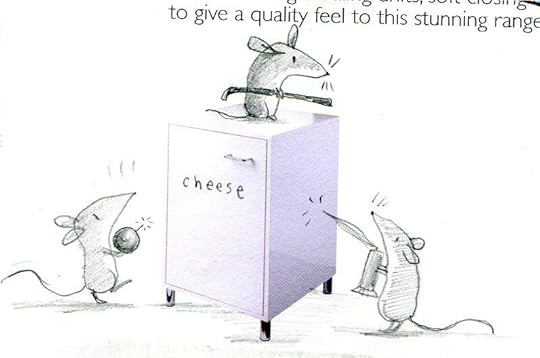
Development work: The Great Cheese Robbery by Tim Warnes (Little Tiger Press, 2015) | Illustration © 2013 by Tim Warnes
Reading The Great Cheese Robbery today (6 years after publication) makes me smile! One reviewer described it as a delightfully offbeat and slyly funny story’, while Booktrust wrote:
This comical story … will delight young readers and is sure to raise a giggle with adults too.
Humour is an effective way of addressing complex ideas and presenting significant issues to children in a non-threatening - and FUN - way! I have to be honest, though - I didn’t set out to write such a funny story. But under the direction of my excellent editor, I hammed up the action. I made it as slapstick (and therefore as non-threatening) as I could. (Without her suggestions, this would have been a very different story indeed.) In her notes to an early draft, the editor advised me to make Cornelius hammier so there’d be no ambiguity about his intentions. Her suggestion was for me to show this ‘both visually and verbally’. First, they pinch the cheese - then everything! Gradually, the ‘capers of the mice could get more and more outrageous’ and more slapstick. She was right: by making the bad guys cartoony and comic, they became non-threatening.
Speaking of fun - do you remember the Where’s Wally books (or Waldo for US readers)? Well, I needed a way of differentiating the three key mice (Cornelius J. Parker and his head goons, Manchego and Mascarpone) from the crowd of fellow burglar mice. So in a direct nod to Wally/Waldo, Manchego wears a red and white striped bobble hat. Mascarpone wears a blue polka dot bandana on his head. Spotting them among ‘the throngs of felonious mice’ becomes a game in itself and supports your child’s visual literacy.
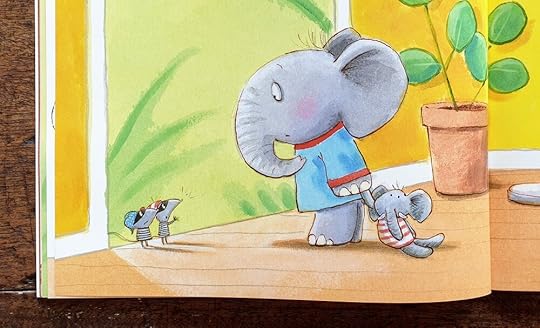
From The Great Cheese Robbery by Tim Warnes (Little Tiger Press, 2015) | Illustration © 2015 by Tim Warnes
In addition to the essential bandit mask, Cornelius himself sports a suit and bowler hat (selected from the start from his rack of disguises).

From The Great Cheese Robbery by Tim Warnes (Little Tiger Press, 2015) | Illustration © 2015 by Tim Warnes
So it’s not just the fridge the marauding mice steal - but the telly, the phone, the fish (in their bowl), the biscuits, the lamp - even Patrick’s toys! Poor Patrick gets increasingly concerned.
“But they’re mine!” [said Patrick.]
“Sorry, kid. Boss said to take the lot!”
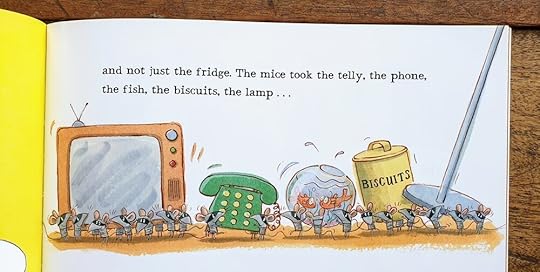
From The Great Cheese Robbery by Tim Warnes (Little Tiger Press, 2015) | Illustration © 2015 by Tim Warnes
The story finally reaches a crisis point. The mice lift up the sofa (complete with Daddy Elephant perched precariously on top)!
Daddy Elephant gave a little whimper as the mice cheered …
“STOP! THAT’S MY DADDY!” Patrick shouted in his biggest, strongest voice. But the mice took no notice.
I love the next spread. Mummy Elephant arrives home - and just in the nick of time. The mice are stopped in their tracks, and Patrick’s relief (as he sheds a little tear) is palpable.
“What’s going on here?” [asks Mummy Elephant.]
‘We’re from the Cheese Inspection Council, Madam. Please step aside.”
“Put my husband down OR ELSE!” shouted Mummy Elephant.
Everybody froze.
Cornelius narrowed his eyes.
“Or else, what?”

From The Great Cheese Robbery by Tim Warnes (Little Tiger Press, 2015) | Illustration © 2015 by Tim Warnes
‘[Mummy Elephant] needs to put them in their place and stop them in their tracks’, wrote my editor. ‘She is a formidable woman. And her trumpet should be swift and merciless!’
And indeed it is - with a mighty PRRRRRRRPPP! she sends those naughty mice flying!
I find it too swift. If I’m honest, I find the ending of Cheese Robbery (although ultimately satisfying) a little abrupt. I tried (in vain) to persuade the publisher to allow me a few extra pages. But additional pages are like gold dust, and Mummy Elephant’s trumpet is necessarily ‘swift and merciless’!
However, as the UK's largest children's reading charity, Booktrust, noted - Cheese Robbery conveys the ‘important message that mummies can be brave and strong as well as daddies’.
The final spread warms my heart!
The Elephant family are reunited on the sofa. Patrick is snuggled between his parents, whose trunks are gently entwined.
“The truth is, Patrick,” said Mummy Elephant, “everyone’s afraid of something - even your big old dad!”
As we learnt from last week’s Story Worth Sharing, Me and My Fear, this is an important message for children to hear. It reminds our kids that it’s okay to be afraid.
It’s normal.
And that’s empowering. (For the record, my secret fear is of earthworms!)
One last thing.
“But he’s still the biggest, strongest elephant around,” said Patrick.
“I am,” smiled Daddy proudly. “But when it comes to mice … Mummy’s the bravest!”
The hand-lettered cover typeface (which I adore) is by the book’s talented designer, Genevieve Webster. She is co-creator of Rastamouse - and a lot of fun! Perhaps that’s where some of the book’s mischievous energy came from?
STORIES WORTH SHARING: The Great Cheese Robbery by Tim WarnesGood to Read because:
It’s ‘a delightfully offbeat and slyly funny story’ that ‘delivers the gentle message: it’s okay to be scared sometimes.’
It’s brilliant fun to read aloud in a variety of silly voices!
It supports your child’s visual literacy - with its use of speech bubbles and the game of Spot the Mice: Cornelius, Manchego and Mascarpone!
GOOD TO READ
Picture books with unexpected visitors
A Bedtime for Bear - Bonny Becker and Kady MacDonald Denton
The Bear - Raymond Briggs
Lost and Found - Oliver Jeffers
The Cat in the Hat by Dr Seuss
BUY THE BOOKPowered by Bookshop.org
Supporting independent bookshops
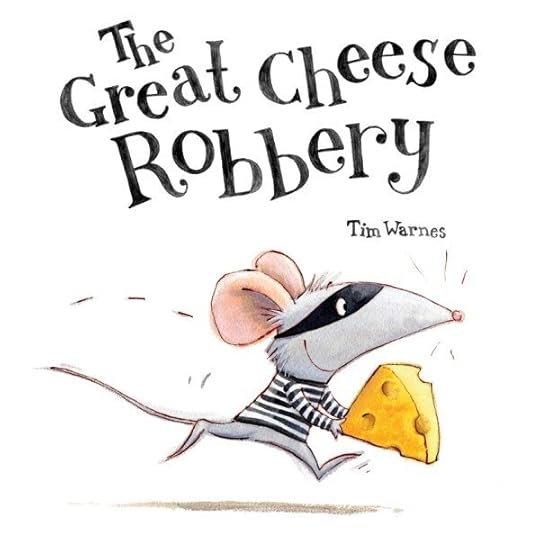
From The Great Cheese Robbery by Tim Warnes (Little Tiger Press, 2015) | Illustration © 2015 by Tim Warnes
‘Warnes puts his special brand of mischief and mayhem into this clever, comical story’
- The Clitheroe Advertiser and Times ‘a really funny read to make you [and your kids] laugh’
- Diapers and daydreams Buy US Buy UK* I EARN COMMISSION FROM THESE LINKS #AD/AFFSOURCESThe Great Cheese Robbery by Tim Warnes (Little Tiger Press, 2015) The Great Cheese Robbery (BookTrust.org.uk) Book Review: Love, adventure and mischief are a gift for Mother’s Day (The Clitheroe Advertiser and Times, Pam Norfolk 25 february 2015) The Great Cheese Robbery by Tim Warnes (Little Tiger Press) (Read it Daddy, 12 February 2015) The Great Cheese Robbery (Books for Keeps)Related articlesFighting Fear with Picture Books A Little Bit Worried Owl Babies © 2021 BY TIM WARNES(UNLESS OTHERWISE ATTRIBUTED)****USE OF THIRD PARTY COPYRIGHTED MATERIAL FALLS UNDER FAIR USE/FAIR DEALING PRACTICE.July 3, 2021
Fighting Fear with Picture Books

From Me and My Fear by Francesca Sanna (Flying Eye Books, 2018) | Illustration © 2018 by Francesca Sanna
Basically, your fear is like a mall cop who thinks he’s a Navy SEAL: He hasn’t slept in days, he’s all hopped up on Red Bull, and he’s liable to shoot at his own shadow in an absurd effort to keep everyone “safe.”— Elizabeth Gilbert, Big Magic: Creative Living Beyond Fear Fear can be a good thing.
Fear stops us from running out in front of cars, diving in unsafe places, and petting rabid dogs.
But it can also be debilitating and prevent us from meeting our potential.
Fear is the master of the "What Ifs?"
What if I fail
What if they laugh at me
What if I can't impress
Etc.
Getting the balance right - between allowing fear reasonable say yet preventing it from becoming sovereign - is an art that most of us attempt to master throughout our lives. (I've previously written about my own battles with anxiety and poor mental health on this blog. ) My Story Worth Sharing this week addresses this balancing act head-on. It's an excellent resource for anxious children - and for those of you wanting to develop empathy in your kids.
Me and My Fear (Flying Eye Books 2018) is created by a self-confessed ‘very anxious person': Francesca Sanna.She explores fear from the point of view of the main character (and narrator) - a dark-haired migrant girl trying to adjust to life in a new country. Like fear, the book's message is universal. And since fear is ubiquitous, all children will relate to the narrator's story in some shape or form.
It's an intriguing picture book in which Sanna cleverly portrays fear as a character - '[a] tiny friend called Fear.'
The narrator's friend is small and dream-like.
White and somewhat amorphous (like a cute, squishy ghost).
Fear accompanies and looks after the girl and - yes - keeps her safe from danger. Which makes Fear a pretty valuable friend to have around - until she starts growing.
Together we have explored new things and stuck by each other.
But since we came to this new country, Fear isn't so little anymore.
Uh-oh.
Sound familiar, anyone?

From Me and My Fear by Francesca Sanna (Flying Eye Books, 2018) | Illustration © 2018 by Francesca Sanna
As the girl's fear grows 'exponentially, both in size and in stubbornness', she effectively imprisons the girl. Fear tells the girl to be alone and afraid - too afraid to explore outside and make new friends. Fear tells her she doesn't understand anyone - and they don't understand her. (Fear has a way of twisting the truth).
As Fear grows in power, she fills and dominates Sanna's soft, retro-styled illustrations. Fear grows so big that she dwarfs the girl, filling the room from floor to ceiling like a mutant Alice. But look closely - the girl (although overwhelmed) is struggling against her Fear.
…but Fear won't move.
The girl's Fear becomes all-encompassing.

From Me and My Fear by Francesca Sanna (Flying Eye Books, 2018) | Illustration © 2018 by Francesca Sanna
She doesn't want the girl to go to school - and isolates her from her new classmates (cleverly depicted by Sanna through white space).
Sanna's illustrations serve the text so well.
As BookTrust explains, Sanna 'represents how debilitating fears can become in a way that really hits home and that many readers will be able to relate to.'
The growing sense of loneliness is palpable. Some of the kids are clearly resentful towards the girl - which isolates her further.
I feel more and more lonely every day.
Fear says it's because no one likes me.

From Me and My Fear by Francesca Sanna (Flying Eye Books, 2018) | Illustration © 2018 by Francesca Sanna
NO! Not true! Fear has overplayed her hand - she is a liar!
Because observant readers will notice a shy-looking boy quietly hanging about. He wants to show the girl something.
Soon we begin to draw and paint together.
The girl and the boy make friends by being creative together. Come break time, the girl wants 'to go outside and play with the boy.' But first, she must persuade and wrestle with Fear - convince her to come outside, too. It works - and now Fear is smiling, looking at the boy's drawing. What's more, Fear is getting smaller - until she is small enough to be carried outside on the girl's back.
As we run through the playground, suddenly a dog barks at us through the fence.
Here's the simple - and clever - twist that speaks volumes of truth.
"AARRGH!" the boy screams and hides quickly behind something strange and small.
Yep. The boy (like most of us, grown-ups included) has his own 'secret Fear'.
(It's what he drew for the girl - and what made the girl's own Fear smile!)
As Mummy Elephant explains to Patrick in my book, The Great Cheese Robbery -
"…[E]veryone's afraid of something - even your big old dad!"
And when the girl realises this, she's empowered.
You may have a fear - but you're not alone.Ensuring your kids understand this fundamental truth (and that there's power in sharing those fears) is vital for everyone's mental health.
Because our fears don't disappear simply by ignoring them. They go away - or at least, their power is diminished - when we help our kids (and each other!) talk about them and externalise them. As Olivia Field, loneliness lead at the British Red Cross, explains: "Talking to people about your worries, about feeling lonely, or simply just about your day, helps.”
Here's how the narrator of Me and My Fear puts it:
Fear is getting smaller each day.
And school is not so difficult anymore.
The story's ending feels complete and comforting. Sanna's final illustrations show a school full of kids and their fears - all of which (notes the Horn Book Review) appear 'small, soft, and smiling.'
Because let's not forget how the story began: Fear can be our friend.
Its presence in our lives is 'not something to be overcome but, rather, understood and embraced.' [Horn Book Review]

From Me and My Fear by Francesca Sanna (Flying Eye Books, 2018) | Illustration © 2018 by Francesca Sanna
Sanna's dedication at the start of the book speaks volumes:
To my mum, who would encourage me to draw my fears, and to my dad, who would share some of his fears with me.
If for nothing else, Me and My Fear is worth sharing for its cleverly constructed story (told through words and rather splendid pictures). But it's perhaps more valuable to parents and carers as a tool to support your children with. Because at some point along the way, we all encounter Fear.
STORIES WORTH SHARING: Me and My Fear by Francesca SannaGood to Read because:
It's an excellent starting point for conversations about social, emotional and mental health.' [Booktrust]
It develops your child's empathy for (and understanding of) kids who are new to their school.
It will reassure your child, reminding them that we all get scared - and that there is power in sharing our fears.
Stories about migrants
The Suitcase by Chris Naylor- Ballesteros
King of the Sky by Nicola Davies and Laura Carling
Stories to reassure anxious kids
Can't You Sleep, Little Bear by Martin Waddell and Barbara Firth
A Little Bit Worried by Ciara Gavin and Tim Warnes
The Great Cheese Robbery by Tim Warnes
Owl Babies by Martin Waddell and Patrick Benson
Related articlesBUY THE BOOKPowered by Bookshop.org
Supporting independent bookshops
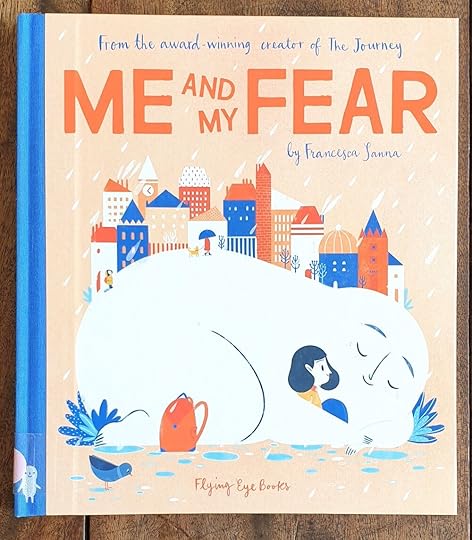
From Me and My Fear by Francesca Sanna (Flying Eye Books, 2018) | Illustration © 2018 by Francesca Sanna
‘a wonderful visual representation of…anxiety’
- Luan Stauss, Laurel Bookstore, Oakland, CA'a heartfelt story exploring fear and anxiety… perfectly balanced, however, by the story's positive outcome...’
- BookTrust Buy UK BUY US* I EARN COMMISSION FROM THESE LINKS #AD/AFFSOURCESBig Magic: Creative Living Beyond Fear by Elizabeth Gilbert Me and my Fear (Book Trust) Me and my Fear (Books for Keeps) Me and My Fear (Kirkus Reviews, 11 September 2018) Review of ME and my Fear (Tom Barthelmess, The Horn Book Inc., 2 January 2019)© 2021 BY TIM WARNES(UNLESS OTHERWISE ATTRIBUTED)****USE OF THIRD PARTY COPYRIGHTED MATERIAL FALLS UNDER FAIR USE/FAIR DEALING PRACTICE.June 25, 2021
Mr Scruff: a diverse read for dog-lovers

From Mr Scruff by Simon James (Walker Books, 2019) | Illustration © 2019 by Simon James | Used by permission of the Publisher
When I was a kid, we briefly had a rescue dog - a dachshund/corgi cross.Just the right size for five-year-old me, Rippy was my constant (and much loved) companion. I have strong memories of wrapping my arm around him as we stood looking outside, Rippy up on his hind legs.
Sadly, Rippy also had the unfortunate habit of urinating up unsuspecting children who visited. And so, he was eventually returned to the rescue centre. He was my friend, and I went along to say goodbye. I think the scars will always be mine to bear - driving away, tears falling, looking out the rear window as we left Rippy to his fate. It was as gut-wrenching as the scene in Toy Story 2 when Jessie the cowgirl is abandoned by her kid.
Fortunately, this week’s Story Worth Sharing has a much happier ending for all concerned! Let me introduce you to Mr Scruff!
Mr Scruff by Simon James (Walker Books 2019) plays on the well-known adage that dogs look like their owners (and vice versa).This notion is cleverly emphasized by James having the owners’ names rhyme with their dogs’.
So we have Polly (a poodle) who resembles her owner, Molly. (Polly and Molly both share tight curls and wear a bow.)
An aloof-looking dachshund named Eric looks suspiciously like his owner, Derek - even down to their dark brown and tan attire.
Mick has Rick.
Lawrence belongs with Florence.
You get the idea!
The jaunty rhyme keeps the pages turning - until finally, we are introduced to the forlorn Mr Scruff.
For Mr Scruff there’s no one.

From Mr Scruff by Simon James (Walker Books, 2019) | Illustration © 2019 by Simon James | Used by permission of the Publisher
This change in pace creates a natural pause (and adds interest to the read-aloud experience). As Tasha Saecker, Assistant Director of the Appleton Public Library, WI, notes:
There are wonderful moments of hesitation built into the text, where the lack of rhyme gives room to pause and wonder a bit.
- Walking Brain Cells
James introduces us to further pampered pooches - before returning us to the rescue centre - and good ol’ Mr Scruff.
I wonder what his back story might be?
We’re told ‘things are looking rough, for poor old Mr Scruff.’
‘That is,’ writes Kirkus Reviews, ‘until Jim…picks out Mr Scruff to be his dog.’
It’s such a tender moment. (Mr Scruff seems somewhat perplexed that someone would pay him attention.) Jim shakes his paw before presenting Mr Scruff to his parents.
It’s a beautifully observed illustration - see how Jim is affectionately (and reassuringly) holding on to Mr Scruff? But Jim’s parents have reservations.
Dad isn’t convinced.
“[A]re you sure? / He’s so BIG and you’re so small!..”
Mum looks concerned.
I can’t help wondering whether the lines, He’s so BIG / and you’re so small! were influenced by the modern artist Andy Warhol.“Surely a puppy would be more fun?”
Because thirty-two years ago, I sketched this: a record of an Andy Warhol drawing on display at the Serpentine Gallery, London.

My 1989 sketch of a 1958 Andy Warhol drawing
It’s from a 1958 drawing by Warhol - and there’s something about the phrasing and idea (and child-like naivety) that caught my attention.
You are so little and you are so big!
Warhol’s playful phrase has stayed with me ever since. I always hoped it would spark a story sometime. It kind of did, in that it was at the front of my mind when I was brainstorming ideas for my picture book, The Great Cheese Robbery.
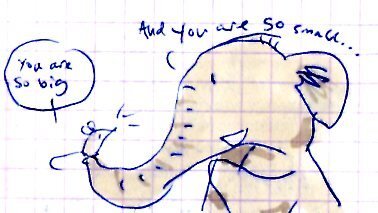
Development idea for The Great Cheese Robbery © by Tim Warnes
The line never made it into my story, although the premise of little Patrick Elephant making friends with the band of teeny-tiny burglar mice kind of encapsulates it. But hats off to Simon James - he executes the same concept beautifully!
But back to Mr Scruff.
Is Jim bothered by the fact that he and Mr Scruff appear to be mismatched? (Their names don’t even rhyme!)
Not at all!
Jim tells his parents, “[Mr. Scruff] needs a home. / A place to call his very own.”

From Mr Scruff by Simon James (Walker Books, 2019) | Illustration © 2019 by Simon James | Used by permission of the Publisher
And though it doesn’t rhyme,
It’s all worked out just fine.
But, wait a minute. Who’s this…?
What was already a delightful story is given an extra twist! Back at the rescue centre, an older, scruffy man arrives to choose a dog. It appears the dishevelled Mr Gruff missed finding his perfect match in Mr Scruff. (Even their names rhyme!)
But like Jim, Mr Gruff isn’t constrained by the familiar. Picking out a little pup, he holds it high and confidently announces:
“I’m so BIG,
And you’re so small.
But that doesn’t matter.
No, not at all!”

From Mr Scruff by Simon James (Walker Books, 2019) | Illustration © 2019 by Simon James | Used by permission of the Publisher
The final illustration shows Mr Gruff leaving the rescue centre, pup in arm, as they gaze lovingly at each other.
‘Can you guess the puppy’s name?
Well, of course -
It’s Tim!’
On the surface, Mr Scruff is a lively, heart-warming story about dogs and the work of rescue centres. As befits a contemporary picture book, it scores highly in terms of diversity: Jim is a brown-skinned boy with interracial parents (a nice touch - and unusual enough to stand out). Scratch a little deeper though, and Mr Scruff raises some interesting (and open-ended) questions about who we choose to be friends with:
Was Mr Scruff adopted by the wrong family?
Should Jim have chosen Tim instead?
Is Mr Scruff better suited to Mr Gruff?
As Booktrust explains:
There’s a gently inclusive message here to look past your preferences, and outside your bubble, and welcome all kinds of different people in your life. People come in all shapes and sizes, and everyone deserves love and kindness...
Having the ability to question expected outcomes and societal norms is a necessary (and valuable) life skill for children to develop. Picture books like Mr Scruff, therefore, are not just great fun to read. They are also rich tools that will give your kids a healthy head start in life.
STORIES WORTH SHARING: Mr Scruff by Simon JamesGood to Read because:It’s a playful picture book that diversifies your child’s bookshelf without even trying.
It’s a heartwarming reminder that friends come in all shapes and sizes.
The flow and pace of the rhyming story make Mr Scruff a joy to read aloud.
GOOD TO READUnusual (but perfectly matched) friends
Up and Down by Oliver Jeffers
Little Nelly’s Big Book by Pippa Goodheart and Andy Rowland
DANGEROUS! by Tim Warnes
Hooray For Amanda & Her Alligator! by Mo Willems
BUY THE BOOKPowered by Bookshop.org
Supporting independent bookshops

‘Diversity in friendships is brought to happy, lively life in this effervescent picture book.’
- Kirkus reviews‘a snuggly, cuddly sort of book that inspires a real sense of belonging and home, as well as appealing to all young animal lovers.’
- Book Trust buy us Buy UK* I EARN COMMISSION FROM THESE LINKS #AD/AFFSOURCESMr Scruff by Simon James (Walker Books, 2019) Review: MR Scruff by Simon james (Walking Brain Cells, 2 october 2019) Mr Scruff (Kirkus Reviews, 24 sept 2019) Mr Scruff (BookTrust)© 2021 BY TIM WARNES(UNLESS OTHERWISE ATTRIBUTED)****USE OF THIRD PARTY COPYRIGHTED MATERIAL FALLS UNDER FAIR USE/FAIR DEALING PRACTICE.June 18, 2021
Are You My Mother?

From Are You My Mother? by P.D. Eastman (Random House, 1960) | Illustration © 1960 by P.D. Eastman
My Good to Read recommendation this week is another oldie but goodie: Are You My Mother? by P.D. Eastman.It’s a timeless classic that won me over way back at nursery school. First published in 1960 (as part of the Random House Beginner Books series, created under the supervision of Dr Seuss), Are You My Mother? is gentle and heart-warming.
Eastman worked at the Walt Disney Studios during the 1930s, later moving to Warner Brothers Cartoons. So, inevitably, his illustrations have a distinct ‘cartoon’ quality which gives them visually expressive personalities. This means they can display strong emotions without the need for words, which adds a great deal to the storytelling – and allows kids to readily engage with them.
The premise of the story is simple enough: a baby bird hatches to find his mother absent (she’s flown off to fetch something for her baby to eat):
“Where is my mother?” [the baby bird] said.
He looked up. He did not see her.
He looked down. He did not see her.
“I will go and look for her,” he said.
Finding your mummy when you don’t even know what she looks like is a challenge! But the baby bird is unphased and determined. He can’t fly yet (of course), so he walks. His naivety adds gentle humour as, ever hopeful, he asks everyone he encounters: “Are you my mother?”
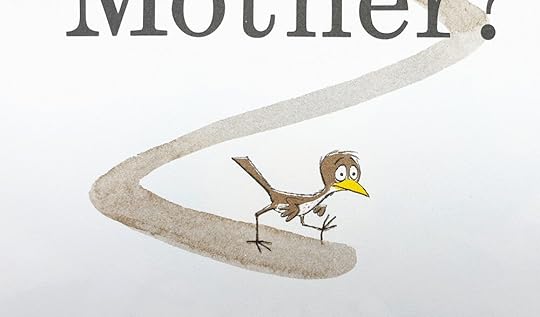
From Are You My Mother? by P.D. Eastman (Random House, 1960) | Illustration © 1960 by P.D. Eastman
“Are you my mother?” he said to the kitten.
The kitten just looked and looked. It did not say a thing.
…
Then he came to a dog.
“Are you my mother?” he said to the dog.
“I am not your mother. I am a dog,” said the dog.
Baby bird scratches his head. Did he have a mother?
Despite the potentially distressing premise (little lost birdie searches for missing mummy), the story is funny – as this former KS2 teacher explains:
My classes of 6-year-olds always laughed when the baby [bird] asked a cow, a dog, a kitten, a chicken and even a boat and an airplane if any of them were his mother. When you’re six, THAT’S comedy!
- Grade Onederful
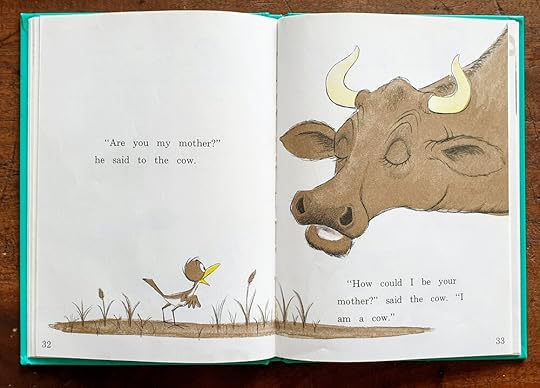
From Are You My Mother? by P.D. Eastman (Random House, 1960) | Illustration © 1960 by P.D. Eastman
I agree – Are You My Mother? is funny (I especially like the cow’s deadpan reply: “How could I be your mother?…I am a cow.”). Yet at the same time, Are You My Mother? also raises an important (and potentially painful) question: What about children with absent mothers? (Perhaps, for example, those raised solely by dad or in foster care.) Of course, there are many reasons why a child may not have one or both parents. How might they cope with the story?
“I did have a mother,” said the baby bird. “I know I did. I have to find her. I will. I WILL!”
I first encountered Are You My Mother? as a child at preschool. I enjoyed being there - but I had separation issues and desperately missed my mummy. Meaning I totally identified with this baby bird – and his happy ending reminded me that I would soon be reunited with my own mummy! The writer of the blog, Allison’s Book Bag, explains her own connection with the story:
My mom died when I was only four. While the baby bird’s mom remains alive and well, his search for his mom emotionally resonated with me then and now. Although he ultimately reunites with his mom, while I grew up without a mom, somehow his happy resolution also continues to give me a sense of peace.
Allison’s Book Bag
As the baby bird becomes ever more determined to find his mummy, he begins to run! He sees a car –
Could that old thing be his mother? No, it could not.
The baby bird did not stop. He ran on and on and on.
He calls out to a boat far below him, ‘but the boat did not stop.’
“Here I am, Mother,” he calls out to a plane. But the plane goes on.
Finally, the baby bird runs up to ‘a big machine’ (mass excavator). Surely this must be his mother? Baby Bird climbs into its bucket.
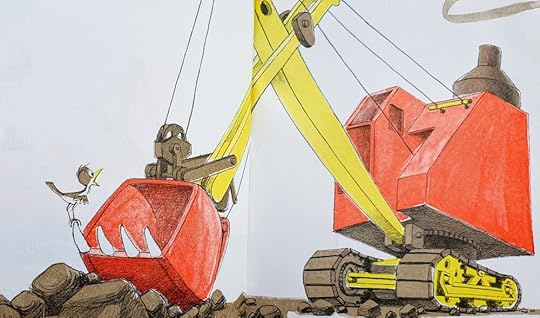
From Are You My Mother? by P.D. Eastman (Random House, 1960) | Illustration © 1960 by P.D. Eastman
The machine lets out a big SNORT! The baby bird can’t escape as he is lifted high.
It went way, way up.
And up, up, up went the baby bird.
Seriously, the suspense will have young readers hooked! So simple, yet packed with drama. And the Snort, it turns out, is crucial to the happy ending:
The Snort put that baby bird right back in the tree.
The baby bird was home!
I still love that happy ending!
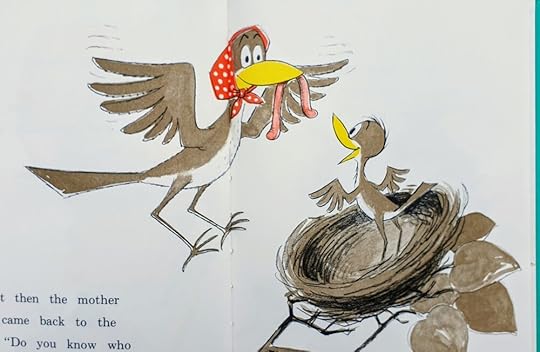
From Are You My Mother? by P.D. Eastman (Random House, 1960) | Illustration © 1960 by P.D. Eastman
Tiny and tenacious, the baby bird is an anti-hero for kids who readily identify with him. His good fortune may be bittersweet for some, but I think ultimately, everyone will find comfort in the story’s resolution.
STORIES WORTH SHARING: Are You My Mother? by P.D. EastmanGood to Read because:
The warm bond between the baby bird and his mother gently affirms children’s relationship with their own mothers.
It’s fun to read aloud - and perfect for encouraging independent reading.
The suspenseful (yet gentle) tale keeps young kids engaged.
GOOD TO READPicture books about missing your mummy
A Bit Lost by Chris Haughton
Come on, Daisy! by Jane Simmons
I Don’t Want To Go To Bed! by Jule Sykes and Tim Warnes
Owl Babies by Martin Waddell and Patrick Benson
BUY THE BOOKPowered by Bookshop.org
Supporting independent bookshops

Are You My Mother? by P.D. Eastman (Random House, 1960) | Illustration © 1960 by P.D. Eastman
‘Its pacing is wonderfully predictable, with not-very-scary tension building to an exciting climax’
- Good Reads
‘basic language and humorous illustrations keep the tale’s tone light’
June 11, 2021
Why The Very Hungry Caterpillar is a classic

From The Very Hungry Caterpillar by Eric Carle (The World Publishing Company, 1969) | © 1969 by Eric Carle
George Bush named Eric Carle’s The Very Hungry Caterpillar as his favourite childhood book although, to many observers’ delight, it wasn’t published until he was twenty three…— Clare Pollard, Fierce Bad RabbitsThe world of children’s publishing recently lost a titan - Mr Eric Carle.
Creator of over 70 picture books, including one of the most recognisable and iconic children’s characters - a tiny and ravenous caterpillar.
The Very Hungry Caterpillar by Eric Carle (Puffin Books) is a classic - and Carle’s best-known work. Fortunately for me, it was first published in 1969 - meaning I got to enjoy it myself as a kid. The Very Hungry Caterpillar is seared into our collective childhood memories, and (according to the publisher) a copy of it is sold somewhere in the world every 30 seconds!
Carle’s combination of simple language and imagery lends the otherwise benign beginning a magical feeling:
In the light of the moon a little egg lay on a leaf.

From The Very Hungry Caterpillar by Eric Carle (The World Publishing Company, 1969) | © 1969 by Eric Carle
Seeing that opening spread takes me straight back to storytime at nursery school.
The moon has a smiling, friendly face - as does the sun on the next page, whose warmth causes the egg to hatch and -
Pop! - Out of the egg came a tiny and very hungry caterpillar.
Hand-painted tissue papers form the basis of Carle’s joyful collage illustrations. Bold and childlike, they reflect the influence of modern artists like Picasso and Matisse (and hark back to Carle’s experience as art director of a New York advertising agency).
The Very Hungry Caterpillar began life as an idea about a week in the life of a bookworm which Carle had while using a hole punch on a pile of papers at his desk. His editor suggested a caterpillar rather than a worm, Carle shouted “Butterfly!” - and a literary classic was conceived.
Even today, The Very Hungry Caterpillar feels unique. As Lucy Mangan writes in her memoir of childhood reading:
‘What entranced me, and millions of other readers since it was published in 1969, was the fact that it was so different from them. The caterpillar had eaten little holes through all the pages for a start. And the pages were all different sizes. Some were narrow enough to make turning them a fiddly business, some large enough to make them flappily unwieldy in tiny hand, and some were just right.’
- Bookworm - A Memoir of Childhood Reading by Lucy Mangan
Ah, yes - those die cut holes that punctuate the pages! I remember poking my fingers through them at nursery school (and the public library), then turning the page to watch them wiggle (alongside the emerging caterpillar) on the other side. “It’s a book you can play with, a toy you can read,” explained Carle. Many years later, I played the same game with my own kids - snuggled up on my lap, a felt tip caterpillar face drawn on their fingertips.
Our insatiable caterpillar friend munches his way through a new kind of choice fruit - starting with one apple on Monday, through to five oranges on Friday.

From The Very Hungry Caterpillar by Eric Carle (The World Publishing Company, 1969) | © 1969 by Eric Carle
It’s a healthy start - ‘[B]ut he was still hungry.’
With each passing day, the pieces of fruit that Caterpillar eats grows incrementally in number. So through repeated readings, children are subtly taught days of the week AND practice their counting.
Saturday’s spread is iconic - a visual smorgasbord of choice American culinary classics, including chocolate cake, ice cream, salami, cherry pie and an exotic slice of watermelon.

From The Very Hungry Caterpillar by Eric Carle (The World Publishing Company, 1969) | © 1969 by Eric Carle
But Caterpillar’s junk food binge has consequences: That night, he suffers from stomach ache. Interestingly, this moral - which Carle considered compromised the message of the book - was insisted upon by the publisher:
“The caterpillar is, after all, very hungry, as sometimes we all are. He has recognized an immense appetite within him and has indulged it, and the experience transforms him, betters him.”
- (Carle in an interview with Paris Review. Source: Fierce Bad Rabbits)
And what a transformation! From a tiny (and very hungry) caterpillar to a giant, fat caterpillar who fills the page and looks fit to burst! He then builds ‘a small house, called a cocoon, around himself’, before finally completing his metamorphosis into a beautiful butterfly!

From The Very Hungry Caterpillar by Eric Carle (The World Publishing Company, 1969) | © 1969 by Eric Carle
The Atlantic article, How The Very Hungry Caterpillar Became a Classic summarises the story thus:
[A] caterpillar hatches out of an egg on a Sunday, proceeds to eat vibrantly colored fruits it finds in escalating quantities from Monday to Friday, goes on a junk-food-eating rampage on Saturday, eats a nice green leaf on Sunday, and then nestles into a cocoon for two weeks and emerges a beautiful butterfly[.]
- The Atlantic
But why did the butterfly come from a cocoon, rather than a chrysalis? On his website, Carle gives what he describes as his ‘unscientific explanation’:
My caterpillar is very unusual. As you know caterpillars don’t eat lollipops and ice cream, so you won’t find my caterpillar in any field guides. But also, when I was a small boy, my father would say, “Eric, come out of your cocoon.” He meant I should open up and be receptive to the world around me. For me, it would not sound right to say, “Come out of your chrysalis.” And so poetry won over science!
- Eric Carle
In a 2019 interview celebrating the 50th anniversary of The Very Hungry Caterpillar, Eric Carle shared his thoughts on the book’s ongoing popularity:
“I believe most children can identify with the helpless, small, insignificant caterpillar, and they rejoice with it when it turns into a beautiful butterfly. It is an affirmation to all children. It says: I too can grow up. I, too, can unfold my wings and fly into the world. I think it’s this message of hope.”
Perhaps Carle’s most significant legacy is not the books themselves but rather the effect that the shared reading of them has had on so many children. In my favourite quote from him, Carle said:
“I feel strongly that by reading with your child, by the simple act of holding them close while you read to them, you let them know that you care for them, have time for them and love them.”
His comment neatly summarises the main reason why I write this blog: To help connect you with your kids through stories worth sharing. Because the days when your children are small are precious and fleeting. So make the most of them before they spread their wings and fly into the world.
STORIES WORTH SHARING: The Very Hungry Caterpillar by Eric CarleGood to Read because:
Children find Carle’s use of bright colours and techniques such as finger painting and paper cutouts inspiring and affirming.
It teaches lessons in counting, the days of the week, the process of metamorphosis, and the importance of choosing foods wisely!
Your kids will find the finger-sized holes irresistible! “It’s a book you can play with, a toy you can read.”
GOOD TO READPicture books about feeling hungry
The Crunching Munching Caterpillar by Sheridan Caine and Jack Tickle
Oh No, George! by Chris Haughton
The Gruffalo by Julia Donaldson and Axel Scheffler
The Little Mouse, The Red Ripe Strawberry and THE BIG HUNGRY BEAR by Don and Audrey Wood
BUY THE BOOKPowered by Bookshop.org
Supporting independent bookshops

From The Very Hungry Caterpillar by Eric Carle (The World Publishing Company, 1969) | © 1969 by Eric Carle
‘The very hungry caterpillar literally eats his way through the pages of the book—and right into your child’s heart…’-
- Mother’s Manual‘Kids ... delight in turning the flaps and poking their fingers through the holes the ever-munching caterpillar has left behind.’
- Common Sense Media buy us Buy UK* I EARN COMMISSION FROM THESE LINKS #AD/AFFSOURCESFierce Bad Rabbits - The Tales Behind Children’s Picture Books by Clare Pollard (Penguin Fig Tree, 2019) The Eric Carle Museum of Picture Book Art Presents: The Very Hungry Caterpillar Turns 50 (Carle Museum, 12 August 2018)Bookworm - A Memoir of Childhood Reading by Lucy Mangan (Vintage, 2018)How The Very Hungry Caterpillar Became a Classic (ashley fetters, the atlantic)get pocket (get pocket) The Official Eric Carle Website (www.eric-carle.com)FOND MEMORIES: The Very Hungry Caterpillar author Eric Carle reveals how his dad reading to him as a young boy helped forge his writing career (thescottishsun, 28 october 2018)
Eric Carle, the author of the very hungry caterpillar, dies age 91 (New York Times)The Very Hungry Caterpillar Turns 50: 'It's [a] Message of Hope,' Says Author Eric Carle (Kate Hogan, 20 march 2019) The Eric Carle Museum of Picture Book Art Presents: The Very Hungry Caterpillar Turns 50 (Amherst, 12 august 2018)© 2021 BY TIM WARNES(UNLESS OTHERWISE ATTRIBUTED)****USE OF THIRD PARTY COPYRIGHTED MATERIAL FALLS UNDER FAIR USE/FAIR DEALING PRACTICE.
June 4, 2021
I’m not cute!: Using picture books to process tricky emotions

Kitten character sketch © 2021 by Tim Warnes
My current illustration project features a kitten.Small, cute and feisty, she knows how to express her frustrations! The story reminds adults that even the youngest of us experience anger. From their perspective, life can feel like a repeating sequence of being dragged from here to there. Or being constantly told, “Do this”, or, “Don’t do that.” And let’s not forget those patronising adults who pinch cheeks and pat heads - well, it’s enough to make any self-respecting toddler (or kitten) have a melt-down! Seeing this reflected in the books they read reassures children that even uncomfortable feelings are normal.
Probably the first picture book to address these undeniable emotions was Maurice Sendak’s groundbreaking, Where the Wild Things Are (1963). Until then, children’s books ‘pictured childhood as a time of exuberant joy and wonder.’ Then along came wolf-boy Max (so angry that he threatens his mother - “I’LL EAT YOU UP!” ):
[Sendak] pictured [childhood] as a dangerous period, where the child was prey to destructive impulses, internal fears, and almost uncontrollable frustrations.
- WILD THINGS! Acts of Mischief in Children’s Literature (Candlewick Press 2014)
An example from my oeuvre is NO!, written by Tracey Cordwell (the first in the series featuring Archie the rhino). It, too, gives voice to young children’s feelings. Picture books like these are significant. Why? Because they tell our kids, I see you - which validates their emotions.
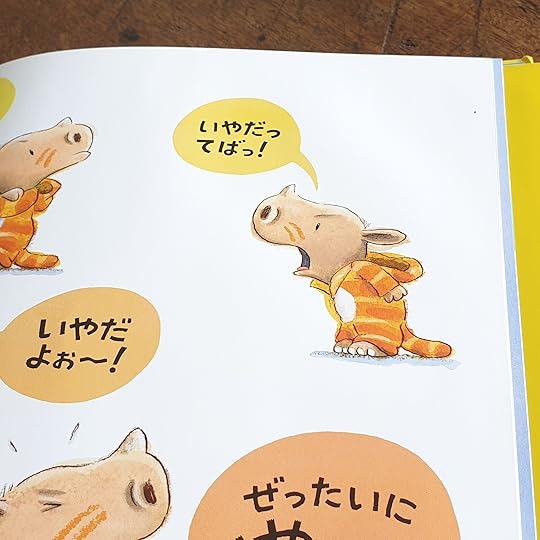
From the Japanese edition of NO! by Tracey Corderoy, ill. by Tim Warnes (Little Tiger Press 2013) | Illustration © 2013 by Tim Warnes
At the same time, they are a lot of fun to illustrate - and for parents - to read aloud! An excellent example is this week’s Story Worth Sharing: I’m not cute! (the first in a series about a grumpy owlet).
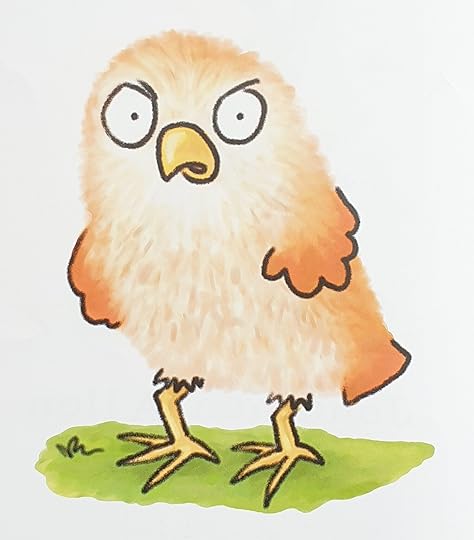
From I’m not cute! by Jonathan Allen (Boxer Books 2005) | Illustration © 2005 by Jonathan Allen
I’m not cute! by Jonathan Allen (Boxer Books 2005) is proof that sometimes the most straightforward stories are the most satisfying.Right from the start, Allen’s Baby Owl looks rather grumpy. He sets off to explore the woods, confident that his glowering face means nobody will bother him.
‘Then along came Rabbit.’
Rabbit’s the first in a succession of walk-on characters, each of whom (undeterred by Baby Owl’s scowling face) insist on picking him up and hugging him.
And they each tell Baby Owl how cute he is!
Which is a problem. Because Baby Owl (undeniably adorable) doesn’t want to be cute (or fluffy)! Infuriated, Baby Owl declares:
“I am a huge and scary hunting machine with great big soft and silent wings.”

From I’m not cute! by Jonathan Allen (Boxer Books 2005) | Illustration © 2005 by Jonathan Allen
Baby Owl demonstrates his predatory prowess by flapping his tiny wings and baring his clawed feet. Fox mistakes these actions for a cute little dance, while Squirrel refers to Baby Owl’s ‘great big see-in-the-dark eyes’ as ‘big baby eyes’ (which really ticks Baby Owl off!).
Along comes Mum. Baby Owl snuggles into her feathery embrace and complains -
“It’s not fair!”… Rabbit, Fox and Squirrel all say I’m cute. But I’m not!”

From I’m not cute! by Jonathan Allen (Boxer Books 2005) | Illustration © 2005 by Jonathan Allen
Now comes a nice little twist to the story. Baby Owl’s mother reassures and agrees with him that he’s not cute (“You’re a huge, scary, sleek, sharp-eyed hunting machine”) and gives him a ‘great big hug’. But Baby Owl has second thoughts. What if, when it comes to mummies, being a scary hunter isn’t enough?
Baby Owl’s expression - a sudden realisation that he wants to be cute as well as an efficient hunting machine - is captured perfectly by writer-illustrator Allen. He describes his work as ‘all about individual character, facial expressions and emotional connection with that character’ - and he pulls it off so well in this book. His characterisation of the little owl is full of emotion and character. From full-on, leg-kicking tantrums to the wide-eyed realisation that, perhaps, being an ace hunter isn’t all it’s cracked up to be.

From I’m not cute! by Jonathan Allen (Boxer Books 2005) | Illustration © 2005 by Jonathan Allen
“But I am cute!” said Baby Owl.
“I am! I AM!”
As with a plethora of picture books, I’m not cute! has (as Publishers Weekly noted) a satisfying “good night” ending. What sets it apart is the wry humour. (Books for Keeps criticised this aspect of the story, regarding it as ‘clearly pitched for the adult reading the book rather than for the pre-school child to whom it is being read.’ I disagree - I think young readers are more sophisticated than that (especially if they experience the outbursts of younger siblings). And the fact that Baby Owl is clearly very annoyed and yet unutterably adorable at the same time is funny in itself.)
Good old Mum recognises an over-tired owlet when she sees one! Tucked into bed, she reads him a story, ‘and Baby Owl [drifts] off to sleep’. But not before one final twist: Mum solves her baby owl’s dilemma by whispering in his ear that he is cute, after all - “for a huge, scary, sleek, sharp-eyed hunting machine, that is.”
Allen’s final image of Baby Owl (tucked up with his cuddly toy owl) is utterly terrifying and will strike fear into the hearts of mice and men! Definitely NOT cute at all…
Sleep easy, Baby Owl!
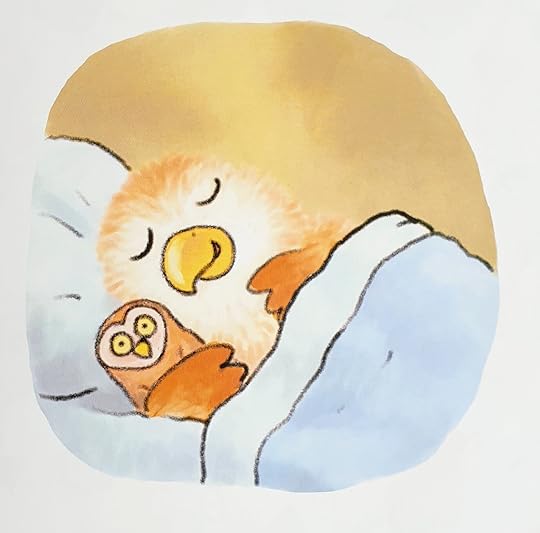
From I’m not cute! by Jonathan Allen (Boxer Books 2005) | Illustration © 2005 by Jonathan Allen
STORIES WORTH SHARING: I’m not cute! by Jonathan AllenGood to Read because:
The simple (and funny) storyline withstands repeated readings.
Children will instantly warm to Baby Owl - and identify with his feelings towards patronising grown-ups!
Young children are validated and affirmed by seeing their emotions (both positive and negative) depicted in stories, opening opportunities for discussion.
GOOD TO READPicture books featuring cute fluffy owlets
Love Enough for Two by Jane Chapman
A Bit Lost by Chris Haughton
Hoot Owl, Master of Disguise by Sean Taylor and Jean Julien
Owl Babies by Martin Waddell and Patrick Benson
BUY THE BOOKPowered by Bookshop.org
Supporting independent bookshops
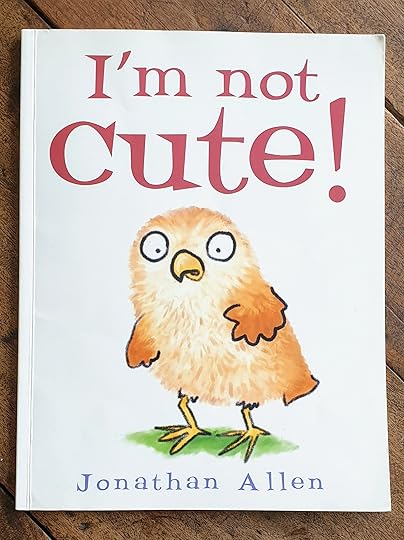
‘Warm, expressive illustrations reveal Baby Owl’s changing emotions with empathy and humour.’
- Book Trust‘Excellent story for my little brother. We first got it from the library and now it is a firm favourite at bedtime.’
- Aoife on Good Reads buy UK buy us* I EARN COMMISSION FROM THESE LINKS #AD/AFFSOURCESI’m not cute! by Jonathan Allen (Boxer Books 2005)WILD THINGS! Acts of Mischief in Children’s Literature by Betsy Bird, Julie Danielson and Peter D. Sieruta (Candlewick Press 2014)NO! by Tracey Corderoy, ill. by Tim Warnes (Little Tiger Press 2013) I’m not Cute! (Kikus Reviews, 1 April 2006) Rummaging and Rummating - Jonathan Allen (Picture Book Den, 15 February 2016) I’m not Cute! (Books for Keeps) I’m Not Cute! (Publishers Weekly)© 2021 BY TIM WARNES(UNLESS OTHERWISE ATTRIBUTED)****USE OF THIRD PARTY COPYRIGHTED MATERIAL FALLS UNDER FAIR USE/FAIR DEALING PRACTICE.May 28, 2021
Last Stop On Market Street

From Last Stop on Market Street by Matt de la Peña, illustrated by Christian Robinson (Putnam 2015) | Illustration © 2015 by Christian Robinson
Grandma’s hands— Bill WithersToday’s Good to Read is Last Stop on Market Street by Matt de la Peña, illustrated by Christian Robinson (Putnam 2015) - and it’s a breath of fresh air.
Clapped in church on Sunday morning
Grandma’s hands
Played a tambourine so well
I can’t think of many other picture books where graffiti-tagged buildings are depicted (let alone mentioned in the text). So hop on the number 5 bus with me to discover the unique qualities of this award-winning book.
The story begins with CJ rushing out of the church service and skipping down the steps.
The outside air smelled like freedom,
but it also smelled like rain,
which freckled CJ’s shirt and dripped down his nose.
Nana shelters CJ under her umbrella as they head to the bus stop.
“How come we gotta wait for the bus in all this wet?”
“Trees get thirsty, too,” his nana told him.
I love how CJ and Nana speak in African American vernacular. Their speech flows naturally - and importantly, reflects so many kids who are sidelined by the majority of kids’ books.
Parents will be familiar with the kind of questions that stream out of CJ. They mostly come from a place of wanting what he doesn’t have (for example, when a friend drives past them as they wait in the rain for the bus, CJ waves, then asks, “Nana, how come we don’t got a car?”). It’s his nana’s response that is so refreshing. She doesn’t give complex answers that try to explain what’s missing. Instead, she presents an alternative way of looking at things - simple truths that highlight the blessings around us.
“Boy, what do we need a car for? We got a bus that breathes fire, and old Mr Dennis, who always has a trick for you.”
The bus creaked to a stop in front of them.
It sighed and sagged, and the doors swung open.
“Some kids ... are just going to see a boy on the bus, and they’re going to be so interested in this bus and who’s on the bus,” says Market Street’s writer, de la Peña in an interview for Scholastic. “Other kids are going to bring different things to the table. Maybe they’re going to be interested in [asking], Why doesn’t CJ have a car? Where his parents? So I think we have to respect where kids are and embrace that version of the story. I think good picture books can exist on different levels depending on where the reader is.”
The passengers to Market Street include a man tuning his guitar, an old woman with a jar of butterflies and a tattooed man on his mobile phone.
Nana gave everyone a great big smile and a “good afternoon”.
She made sure CJ did the same.
I just want to hug Nana! She embodies that Bill Wither’s song, Grandma’s Hands, and is depicted with positivity and warmth in both words and pictures.
She interacts with her fellow passengers with love and respect.
Her thoughtful answers to CJ’s (increasingly tricky) questions overflow with compassion and a zest for life.
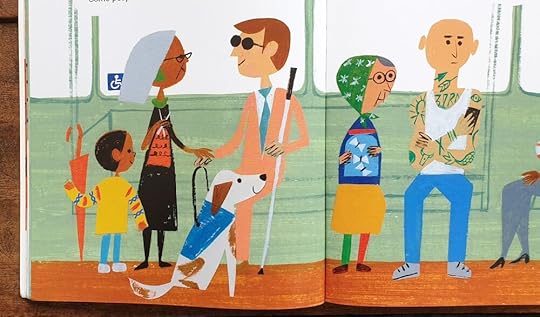
From Last Stop on Market Street by Matt de la Peña, illustrated by Christian Robinson (Putnam 2015) | Illustration © 2015 by Christian Robinson
A man climbed aboard with a spotted dog.
CJ gave up his seat. “How come that man can’t see?”
“Boy, what do you know about seeing?” Nana told him.
“Some people watch the world with their ears.”
“That’s a fact. Their noses, too,” the man said, sniffing at the air…
Nana squeezed the man’s hand and laughed her deep laugh.
This interaction must be one of the most moving things I’ve seen in a picture book. It embodies Nana’s philosophy and the lesson she’s teaching CJ: Things aren’t always as they appear. We must look past the surface for the beauty beneath. As the review on Social Justice Books notes, ‘Nana creates opportunities for CJ to notice, to attend thoughtfully to his world.’
Market Street is a slightly longer read than many picture books. Trust me, that’s no hardship since de la Peña’s words have cadence and rhythm. “I feel like the job of the picture book writer is twofold,” he says. “You have to get the story right, but then you have to get the music right, too. [So] I’ll try to get the story in good shape. Then I go in and really think about the sounds. What sounds are going together?” For de la Peña, “[a] picture book isn’t just a story. It’s almost like a song that you sing over and over again.”
As the story reaches its conclusion, CJ and his nana depart the bus at the last stop on Market Street. Downtown is portrayed with a rare realism in kid’s picture books—razor wire loops along the top of a chain-link fence. A homeless guy pushes a shopping cart piled with possessions. There are ‘graffiti-tagged windows and boarded-up stores.’

From Last Stop on Market Street by Matt de la Peña, illustrated by Christian Robinson (Putnam 2015) | Illustration © 2015 by Christian Robinson
“It was so important for me to show the city as it feels, as I experience it,” says Robinson. “CJ wonders why this community is so dirty and why the stores are boarded up and why windows are broken. Because that’s the reality - that’s how some neighbourhoods look. Not every community in a picture book needs to have tree-lined streets and picket fences.”
“How come it’s always so dirty over here?”
[Nana] smiled and pointed to the sky.
“Sometimes when you’re surrounded by dirt, CJ, you’re a better witness for what’s beautiful.”
What a great moment!
CJ and his nana continue their journey on foot, walking hand in hand to their destination. Finally, CJ spots some familiar (friendly) faces and says, “I’m glad we came.”
The ending is so heart-warming and totally unexpected. Nana and CJ are spending the afternoon at the soup kitchen, feeding the needy. Men and women, young and old - in a whole range of skin tones.
‘[T]his final detail ... provides a gentle twist, letting readers in on the secret Nana and CJ have known all along: They’re on the way to help others who have even less.’
New York Times review of Last Stop on Market Street
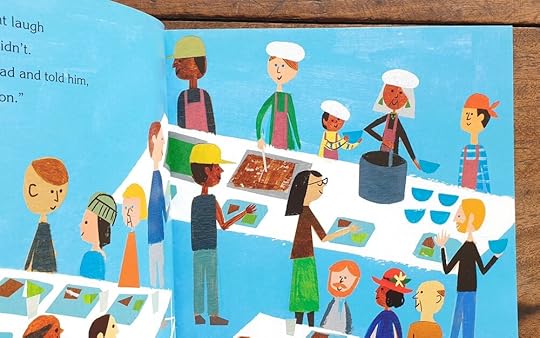
From Last Stop on Market Street by Matt de la Peña, illustrated by Christian Robinson (Putnam 2015) | Illustration © 2015 by Christian Robinson
Last Stop On Market Street is bright, bold and colourful, and continues the legacy of Ezra Jack Keats. Combined with de la Peña’s beautiful prose, this picture book is a pleasure to read. And it is unique in its honest depiction of the hardship of life, particularly for urban communities, and acknowledging that not everyone has access to the same opportunities.
The creators of Last Stop on Market Street do not come from the usual privileged demographic of picturebook makers. Like the main characters, Robinson (raised by his own grandmother under challenging circumstances) is African American. De la Peña is a Latino writer. They are regular collaborators, and their books bring a new - and welcome - perspective to the world of children’s books.
But ultimately, Market Street is not about race. It’s about choosing one’s perspective on life. As de la Peña explains, “You can feel like you have been slighted if you are growing up without if you have less money - or you can see the beauty in that.”
STORIES WORTH SHARING: Last Stop On Market Street by Matt de la Peña and Christian Robinson
Good to Read because:
Their journey to Market Street explores important themes of inclusion and kindness.
The African American vernacular dialect (e.g. “How come we don’t got a car?”) is refreshing - making the story even more relatable to kids who speak that way.
It reminds us to appreciate our surroundings, find beauty in the mundane - and value what we have.
GOOD TO READ
Picture books that celebrate grandparents
Love Enough for Two by Jane Chapman
Grandad’s Island by Benji Davies
The Wild Wood by Simon James
Last Stop On Market Street by Matt de la Peña and Christian Robinson
BUY THE BOOKPowered by Bookshop.org
Supporting independent bookshops
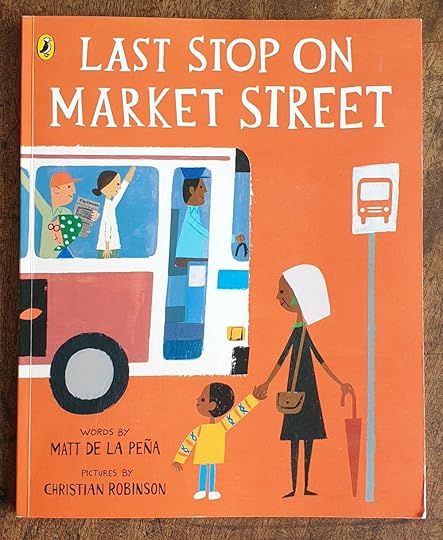
From Last Stop on Market Street by Matt de la Peña, illustrated by Christian Robinson (Putnam 2015) | Illustration © 2015 by Christian Robinson
‘[A] wonderful picture book about appreciating the riches that money can’t buy’
- Booktrust‘a textual and artistic tour de force.”
- Kirkus Reviews buy us Buy UK* I EARN COMMISSION FROM THESE LINKS #AD/AFFSOURCESLast Stop On Market Street by Matt de la Peña and Christian Robinson (Putnam 2015) Last Stop On Market Street (booktrust.org) Interview with Matt de la Peña and Christian Robinson: Why the Creators of Last Stop on Market Street Believe Kids Need to See Themselves in Books (Traci Swain, Judynewmanatscholastic.com) Last Stop on market street - Review by Pat Enciso (Socialjusticbooks.org) 'Last Stop On Market Street' Wins Newbery Medal, 'Finding Winnie' Takes Caldecott (Lynn Neary. Petra Mayer, npr.org, 11 january 2016)© 2021 BY TIM WARNES(UNLESS OTHERWISE ATTRIBUTED)****USE OF THIRD PARTY COPYRIGHTED MATERIAL FALLS UNDER FAIR USE/FAIR DEALING PRACTICE.May 21, 2021
Take a walk on the wild side: Hike

From Hike by Pete Oswald (Walker Books 2020) | Illustration © by Pete Oswald 2020 | Used by permission
[P]ay attention. Pay attention to books, pay attention to art. Most importantly, pay attention to life. Life experiences [are] where the true stories come from…— Pete OswaldIf there’s one thing the pandemic has taught us, it’s that time - and life - are short.
My Good to Read recommendation this week is Hike by Pete Oswald (Walker Books 2020). It’s a tonic for the soul - and a timely reminder of what life should be about: Quality time with the ones we love.
In a nutshell, the story tells of a father and son ‘witnessing the magic of the wilderness, overcoming challenges and playing a small role in the survival of the forest.’ Loosely based on his childhood in Utah, Oswald describes Hike as deeply personal - and a love letter to nature:
“My family and I spent most of our free time in nature. Instead of going to Disneyland or traditional vacations for the summer, we would take a family backpacking trip to Southern Utah. My father is an avid outdoorsman, and his love of wildlife played a huge role in our family. All of our vacations were centred around camping, hiking, exploring [and] adventures. As a child, I always loved it, but it wasn’t until I had children of my own that I realised how influential it was to me.”
- An interview with Pete Oswald
I think when an illustrator draws on deeply personal memories, there is a depth - a warmth - to the art that only experience (and fond remembrance) can bring.
An example of this in my own work would be Jesus Loves Me, which, like Oswald’s Hike, stitches together fragments of treasured family memories.
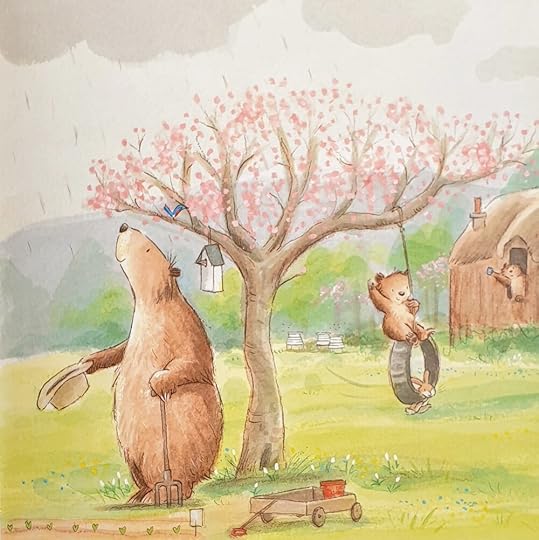
From Jesus Loves Me! by Tim Warnes (Simon & Schuster 2006) | Illustration © 2006 by Tim Warnes
Oswald uses his childhood memories (‘the sound of a rushing waterfall, the smell of wildflowers, the sight of an eagle’) to create the story of Hike. He channels them into a picture book that will inspire your family to get out and connect with nature (and perhaps to begin some family traditions of your own).
Hike is a wordless picture book. More accurately, near-wordless, since the words - such as munch, click and miaow - are few and far between. (Like a comic, they are used as sound effects.) The story begins ‘in the cool and quiet early light of morning, [as] a father and child wake up.’ The kid’s room is strewn with an adventurer’s paraphernalia: binoculars, notebooks, maps, camera and compass - clues to the day ahead. The preparations are described - visually - in small vignettes that add a tremendous amount of detail and help convey the child’s building excitement.

From Hike by Pete Oswald (Walker Books 2020) | Illustration © by Pete Oswald 2020 | Used by permission
Coat on - ZIP!
Boots tied.
Bobble hat on.
Backpack filled.
They load their RV and head out of the city into the wild.
These more minor details contrast with dramatic scenes of nature, culminating in a double-page vista from the mountain top, complete with soaring eagles.
On one level, you have the basic storyline of Hike: a father and child going on an adventure in nature. People hike for various reasons - to connect with nature, to get fresh air and exercise, for the sense of adventure. And all of those are true for the characters in this book. But look closely, and you’ll discover an extra purpose behind their trip - told entirely through the illustrations.
Don’t underestimate wordless (or - in this case - near-wordless) picture books. Despite first impressions, they can have complex narrative structures. They allow observant readers to discover deeper stories hidden below the surface. The deeper narrative of Hike feels like it’s buried below the surface. Yet, in reality, it’s hidden in plain sight - waiting for a child’s enquiring mind to search it out.
Oswald leaves little clues right at the start in the child’s bedroom:
The bedspread, patterned with trees.
A family album beside the bed.
On the table: an open book detailing How to Plant a Tree, a trowel, and a conifer seedling in a protective tube.

From Hike by Pete Oswald (Walker Books 2020) | Illustration © by Pete Oswald 2020 | Used by permission
Right at the end, the events come together and the secret’s revealed. Father and son have continued a family tradition - and planted a tree in the wilderness.
All good picture books convey additional (sometimes conflicting) information through the illustrations. These wordless clues are like treasure to a young child - they empower them, enabling them to participate and add to the storytelling.
[N]ot having words allow[s] us to slow down and spend time noticing details in the illustrations. We also learn... how much language is generated when collaborating to make a story from the pictures; quite an irony for a supposedly ‘silent’ picture book.
Momo Time to Read
Oswald reveals that he found learning to read difficult. So it’s perhaps no coincidence that his first solo picture book is wordless. He says, “Ever since I was young, I’ve always loved wordless picture books because I could put my own spin on [them] and make the story very personal. Empowering the reader to make the story personal seems appropriate for this book.”
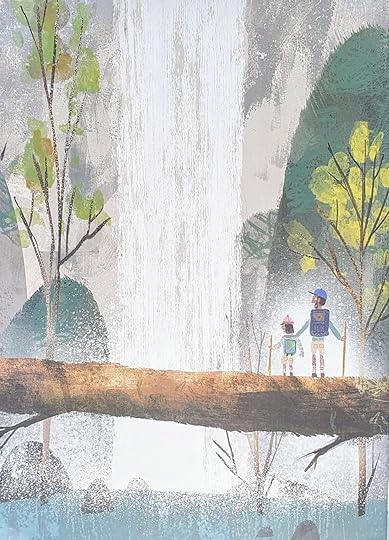
From Hike by Pete Oswald (Walker Books 2020) | Illustration © by Pete Oswald 2020 | Used by permission
One of Oswald’s favourite illustrations in Hike shows the father and child standing on a giant log, gazing up in wonder at a majestic waterfall. I have a very similar illustration in my forthcoming book, I Love You Night and Day. It’s included for the same reason as Oswald’s scene: to create an atmosphere of wonder.
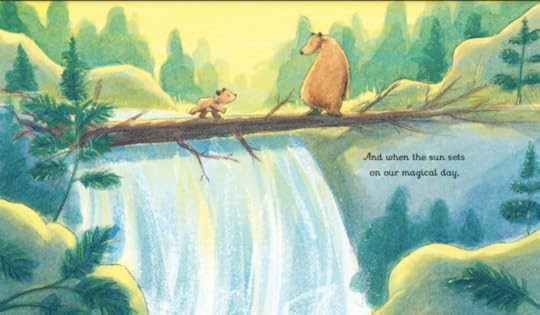
From I Love You Night and Day by Amelia Hepworth and Tim Warnes (Little Tiger Press 2022) | Illustration © 2022 by Tim Warnes
[It’s] actually the first illustration that I did that helped inspire this whole story. It’s based on a hike that my father and I would take, and we look at this waterfall. It’s kind of a bunch of snippets of those hikes from my early age. … I wanted to tell a story that had … this connection to nature because I think when we get outside, and we get away from our devices, we can connect with nature. We can connect with others, and we can ultimately connect with ourselves.
- AN INTERVIEW WITH PETE OSWALD
Finally, a word about the human characters: with dark skin, they tick the diversity box. And since Hike is a wordless book, the child is not defined as ‘he’ or’ she.’ They have cropped hair, a green backpack and wears a pink beanie with knee-high socks. Making the child gender-neutral was a deliberate - and clever - decision of Oswald’s.
And what of the man? The publisher’s blurb defines him as ‘father’ (and Oswald built on his own memories of time with his dad). But the wordless format allows us more flexibility - he could, for example, be ‘Uncle’. Most notably though - the mother is absent. A detail which could open up some constructive conversations with older kids - and will allow many children to see their own lives reflected.
STORIES WORTH SHARING: Hike by Pete Oswald
Good to Read because:
It’s a love letter to nature that will inspire your children to get out and explore!
Dark-skinned characters, a gender-neutral child and a celebration of the father-child relationship makes this inclusive and an excellent book to diversify your kid’s bookshelf.
The wordless narrative and sequential storytelling will develop your child’s visual literacy, spark conversation and connect you with your kid.
Good to ReadIn celebration of dads
Only My Dad and Me by Alyssa Satin Capucelli, ill. by Tiphanie Beake
Just Like You by Jane Chapman
So Much by Trish Cooke, ill. by Helen Oxenbury
Daddy Hug by Tim Warnes, ill. by Jane Chapman
BUY THE BOOKPowered by Bookshop.org
Supporting independent bookshops
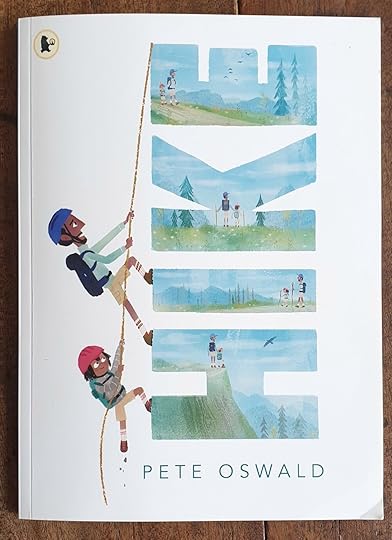
From Hike by Pete Oswald (Walker Books 2020) | Illustration © by Pete Oswald 2020 | Used by permission
‘As soothing as a walk in the woods’
- New York Times‘an immersive experience that invites repeated visits.’
- Kirkus Reviews buy uk buy us* I EARN COMMISSION FROM THESE LINKS #AD/AFFSOURCESHike by Pete Oswald (Walker Books 2020) Lets Talk Picture Books: Pete Oswald (Letstalkpicturebooks.com, 13 February 2021) Hike: Pete Oswald (The CILIP Carnegie & Kate Greenaway Children’s Book) Hike by Pete Oswald (Momo Celebrating Time To Read, 16 January 2021)© 2021 BY TIM WARNES(UNLESS OTHERWISE ATTRIBUTED)****USE OF THIRD PARTY COPYRIGHTED MATERIAL FALLS UNDER FAIR USE/FAIR DEALING PRACTICE.My Life in Books
For lovers of kid lit, this memoir - My Life in Books - is intended to give you the confidence and encouragement to share your own passion; to help you make lasting connections through kids’ books.
Originally posted at www.timwarnes.com ...more
- Tim Warnes's profile
- 30 followers



